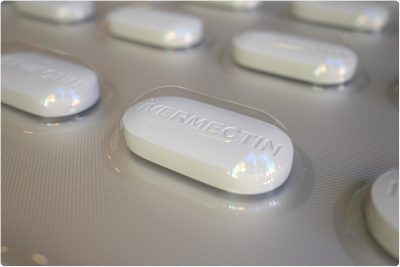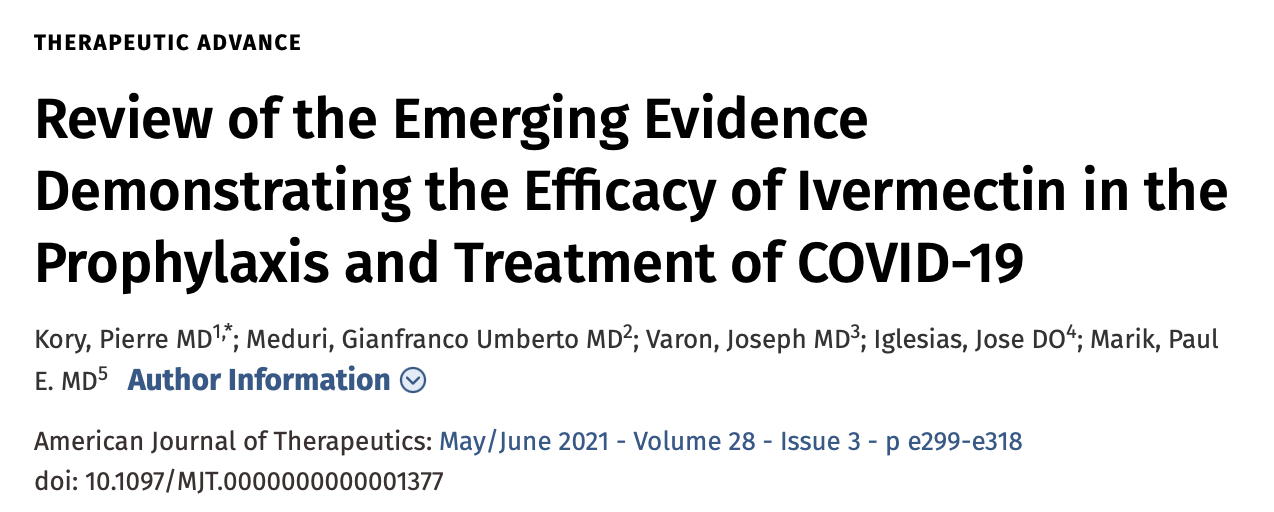Emerging Evidence Demonstrating the Efficacy of Ivermectin in the Prophylaxis and Treatment of COVID-19

All Global Research articles can be read in 51 languages by activating the “Translate Website” drop down menu on the top banner of our home page (Desktop version).
Visit and follow us on Instagram at @crg_globalresearch.
***
Abstract
Background
After COVID-19 emerged on U.S shores, providers began reviewing the emerging basic science, translational, and clinical data to identify potentially effective treatment options. In addition, a multitude of both novel and repurposed therapeutic agents were used empirically and studied within clinical trials.
Areas of Uncertainty
The majority of trialed agents have failed to provide reproducible, definitive proof of efficacy in reducing the mortality of COVID-19 with the exception of corticosteroids in moderate to severe disease. Recently, evidence has emerged that the oral antiparasitic agent ivermectin exhibits numerous antiviral and anti-inflammatory mechanisms with trial results reporting significant outcome benefits. Given some have not passed peer review, several expert groups including Unitaid/World Health Organization have undertaken a systematic global effort to contact all active trial investigators to rapidly gather the data needed to grade and perform meta-analyses.
Data Sources
Data were sourced from published peer-reviewed studies, manuscripts posted to preprint servers, expert meta-analyses, and numerous epidemiological analyses of regions with ivermectin distribution campaigns.
Therapeutic Advances
A large majority of randomized and observational controlled trials of ivermectin are reporting repeated, large magnitude improvements in clinical outcomes. Numerous prophylaxis trials demonstrate that regular ivermectin use leads to large reductions in transmission. Multiple, large “natural experiments” occurred in regions that initiated “ivermectin distribution” campaigns followed by tight, reproducible, temporally associated decreases in case counts and case fatality rates compared with nearby regions without such campaigns.
Conclusions
Meta-analyses based on 18 randomized controlled treatment trials of ivermectin in COVID-19 have found large, statistically significant reductions in mortality, time to clinical recovery, and time to viral clearance. Furthermore, results from numerous controlled prophylaxis trials report significantly reduced risks of contracting COVID-19 with the regular use of ivermectin. Finally, the many examples of ivermectin distribution campaigns leading to rapid population-wide decreases in morbidity and mortality indicate that an oral agent effective in all phases of COVID-19 has been identified.
*
Introduction
In early 2020, on the onset of the spreading pandemic, many providers and institutions began to continuously review the rapidly emerging basic science, translational, and clinical data to identify potentially effective treatment options for COVID-19. Although there is now a small and increasing number of therapeutics showing some efficacy in important clinical outcomes, chief of which are corticosteroids in moderate to severe illness, the world continues to suffer from a worsening crisis with the potential of again overwhelming hospitals and intensive care units (ICU). As of February 21, 2020, the number of deaths attributed to COVID-19 in the United States reached 510,248 with more than 9.3 million active cases, the highest number to date. In addition, multiple European countries have imposed new rounds of restrictions and lockdowns.
Further compounding these alarming developments was a wave of recently published results from therapeutic randomized controlled trials conducted on medicines believed effective for COVID-19 that found a lack of impact on mortality in hospitalized patients with the use of remdesivir, hydroxychloroquine, lopinavir/ritonavir, interferon, convalescent plasma, and monoclonal antibody therapy.1–4 One year into the pandemic, the only therapy considered “proven” as a life-saving treatment in COVID-19 is the use of corticosteroids in patients with moderate to severe illness.5,6 Similarly, most concerning is the fact that no agent has yet proven effective in outpatients to prevent disease progression to prevent hospitalization.
More recently, trial results of ivermectin, a widely used antiparasitic medicine with known antiviral and anti-inflammatory properties, have been showing benefits in multiple important clinical and virologic outcomes, including mortality. Although growing numbers of the studies supporting this conclusion have passed through peer review, approximately half of the remaining trials data are from manuscripts uploaded to medical preprint servers, a now standard practice for both rapid dissemination and adoption of new therapeutics throughout the pandemic. Following is a comprehensive review of the available efficacy data as of December 12, 2020, taken from in vitro, animal, clinical, and real-world studies all showing the above impacts of ivermectin in COVID-19.
History of ivermectin
In 1975, Professor Satoshi Omura at the Kitsato institute in Japan isolated an unusual Streptomyces bacterium from the soil near a golf course along the southeast coast of Honshu, Japan. Omura, along with William Campbell, found that the bacterial culture could cure mice infected with the roundworm Heligmosomoides polygyrus. Campbell isolated the active compounds from the bacterial culture, naming them “avermectins” and the bacterium S. avermitilis for the compounds’ ability to clear mice of worms.7 Despite decades of searching around the world, the Japanese microorganism remains the only source of avermectin ever found. Ivermectin, a derivative of avermectin, then proved revolutionary. Originally introduced as a veterinary drug, it soon made historic impacts in human health, improving the nutrition, general health, and well-being of billions of people worldwide ever since it was first used to treat onchocerciasis (river blindness) in humans in 1988. It proved ideal in many ways, given that it was highly effective, broad-spectrum, safe, well tolerated, and could be easily administered.7 Although it was used to treat a variety of internal nematode infections, it was most known as the essential mainstay of 2 global disease elimination campaigns that has nearly eliminated the world of two of its most disfiguring and devastating diseases. The unprecedented partnership between Merck & Co. Inc, and the Kitasato Institute combined with the aid of international health care organizations has been recognized by many experts as one of the greatest medical accomplishments of the 20th century. One example was the decision by Merck & Co to donate ivermectin doses to support the Mectizan Donation Program that then provided more than 570 million treatments in its first 20 years alone.8 Ivermectin’s impacts in controlling onchocerciasis and lymphatic filariasis, diseases which blighted the lives of billions of the poor and disadvantaged throughout the tropics, is why its discoverers were awarded the Nobel Prize in Medicine in 2015 and the reason for its inclusion on the World Health Organization’s (WHO) “List of Essential Medicines.” Furthermore, it has also been used to successfully overcome several other human diseases and new uses for it are continually being found.7
Preclinical studies of Ivermectin’s activity against SARS-CoV-2
Since 2012, a growing number of cellular studies have demonstrated that ivermectin has antiviral properties against an increasing number of RNA viruses, including influenza, Zika, HIV, Dengue, and most importantly, SARS-CoV-2.9–17Insights into the mechanisms of action by which ivermectin both interferes with the entrance and replication of SARS-CoV-2 within human cells are mounting. Caly et al18 first reported that ivermectin significantly inhibits SARS-CoV-2 replication in a cell culture model, observing the near absence of all viral material 48 hours after exposure to ivermectin. However, some questioned whether this observation is generalizable clinically given the inability to achieve similar tissue concentrations used in their experimental model using standard or even massive doses of ivermectin.19,20 It should be noted that the concentrations required for an effect in cell culture models bear little resemblance to human physiology given the absence of an active immune system working synergistically with a therapeutic agent, such as ivermectin. Furthermore, prolonged durations of exposure to a drug likely would require a fraction of the dosing in short-term cell model exposure. Furthermore, multiple coexisting or alternate mechanisms of action likely explain the clinical effects observed, such as the competitive binding of ivermectin with the host receptor-binding region of SARS-CoV-2 spike protein, as proposed in 6 molecular modeling studies.21–26 In 4 of the studies, ivermectin was identified as having the highest or among the highest of binding affinities to spike protein S1 binding domains of SARS-CoV-2 among hundreds of molecules collectively examined, with ivermectin not being the particular focus of study in 4 of these studies.27 This is the same mechanism by which viral antibodies, in particular, those generated by the Pfizer and Moderna vaccines contain the SARS-CoV-2 virus. The high binding activity of ivermectin to the SARS-CoV-2 spike protein could limit binding to either the ACE-2 receptor or sialic acid receptors, respectively, either preventing cellular entry of the virus or preventing hemagglutination, a recently proposed pathologic mechanism in COVID-19.21,22,26–28 Ivermectin has also been shown to bind to or interfere with multiple essential structural and nonstructural proteins required by the virus to replicate.26,29 Finally, ivermectin also binds to the SARS-CoV-2 RNA-dependent RNA polymerase (RdRp), thereby inhibiting viral replication.30
Arevalo et al investigated in a murine model infected with a type 2 family RNA coronavirus similar to SARS-CoV-2, (mouse hepatitis virus), the response to 500 μg/kg of ivermectin versus placebo.31 The study included 40 infected mice, with 20 treated with ivermectin, 20 with phosphate-buffered saline, and then 16 uninfected control mice that were also given phosphate-buffered saline. At day 5, all the mice were killed to obtain tissues for examination and viral load assessment. The 20 nonivermectin-treated infected mice all showed severe hepatocellular necrosis surrounded by a severe lymphoplasmacytic inflammatory infiltration associated with a high hepatic viral load (52,158), whereas in the ivermectin-treated mice a much lower viral load was measured (23,192; P < 0.05), with only few livers in the ivermectin-treated mice showing histopathological damage such that the differences between the livers from the uninfected control mice were not statistically significant.
Dias De Melo et al32 recently posted the results of a study they did with golden hamsters that were intranasally inoculated with SARS-CoV-2 virus, and at the time of the infection, the animals also received a single subcutaneous injection of ivermectin at a dose of 0.4 mg/kg on day 1. Control animals received only the physiologic solution. They found the following among the ivermectin-treated hamsters: a dramatic reduction in anosmia (33.3% vs. 83.3%, P = 0.03), which was also sex dependent in that the male hamsters exhibited a reduction in clinical score while the treated female hamsters failed to show any sign of anosmia. They also found significant reductions in cytokine concentrations in the nasal turbinates and lungs of the treated animals, despite the lack of apparent differences in viral titers.
Despite these mounting insights into the existing and potential mechanisms of action of ivermectin both as a prophylactic and treatment agent, it must be emphasized that significant research gaps remain and that many further in vitro and animal studies should be undertaken to better define not only these mechanisms but also to further support ivermectin’s role as a prophylactic agent, especially in the optimal dose and frequency required.
Click here to read the full article published by the American Journal of Therapeutics.
*
Note to readers: Please click the share buttons above or below. Follow us on Instagram, @crg_globalresearch. Forward this article to your email lists. Crosspost on your blog site, internet forums. etc.
Full authors
Kory, Pierre MD; Meduri, Gianfranco Umberto MD; Varon, Joseph MD; Iglesias, Jose DO; Marik, Paul E. MD
Featured image is from Novikov Aleksey / Shutterstock









Nessun commento:
Posta un commento